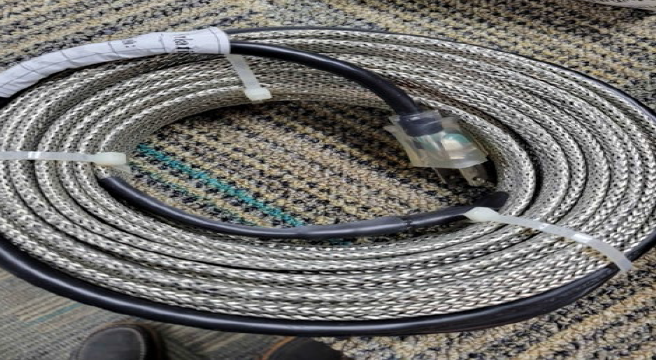(WASHINGTON) — The U.S. Coast Guard recently investigated a fire on board an inspected towing vessel that resulted in the vessel suffering a loss of propulsion. The source of the fire was determined to be heat cables (also referred to as heat tracing cable or heat tape), which were improperly installed to prevent condensate from forming and freezing within hoses used to transmit compressed air for the vessel’s air-operated engine throttle control system.
The heat cables were designed to be installed on fixed piping systems. They were not designed to be used on hoses or in applications which subjected the heat cables to movement. This installation had the heat cables wrapped around hoses connected to a retractable pilothouse, which would move whenever the pilothouse was raised or lowered. This movement subjected the heat cables to stresses from flexing and bending for which they were not designed.

The manufacturer’s instructions, National Fire Protection Association (NFPA) 70, the National Electric Code (NEC), and standards from the Institute of Electrical and Electronics Engineers (IEEE) require heat cables to be installed with ground-fault protection and specifically warn that this is required to prevent a fire or electric shock if the heat cable is damaged. Neither the 120-volt receptacle or the circuit breaker which provided power to the heat cables met this critical safety requirement. Lastly, the insulation utilized to wrap the hoses and the heat cables was not fire-resistant as required by the heat cable manufacturer.
While there are no regulations under Title 46 Code of Federal Regulations (CFR) which specifically address the installation of heat cables, there are regulations which require electrical systems and equipment to be designed, installed and maintained to provide for the safety of the vessel, and protect people on board from electrical hazards (including fire and electric shock).
The Coast Guard strongly recommends that vessel owners, inspectors and third-party surveyors:
• Inspect the installation of all heat cables installed on board vessels to ensure they are designed, installed and maintained in accordance with all manufacturer installation instructions and warnings. This includes strict adherence to bend radius limitations and the use of ground-fault protected electrical circuits.
• Heat tracing cables should be listed to meet UL 515, and in consultation with the cable manufacturer be verified safe for both use in the marine environment and in the intended application on board the vessel. This is critical to ensuring safe vessel operations and to protect personnel from electrical hazards, including fire and electric shock.
• For heat cable installations involving vital systems (i.e. propulsion controls, steering systems), a review of potential vulnerabilities of the effected vital system should be conducted. Implement steps to minimize the risk of an unexpected failure of the vital system resulting from a heat cable failure or the ground-fault circuit protection tripping offline.
• Implement an inspection and maintenance program as required by the heat cable manufacturer’s instructions. This typically requires insulation resistance readings taken post-installation, and at specified intervals to ensure the insulation is not breaking down. Heat cables with insulation resistances found below the manufacturer’s specified values should be removed and replaced as soon as possible.
This safety alert is provided for informational purposes only and does not relieve any domestic or international safety, operational or material requirement. Developed by Marine Safety Unit Chicago and distributed by the Office of Investigations and Analysis. Questions may be sent to HQS-SMB-CG-INV@uscg.mil.
– U.S. Coast Guard

